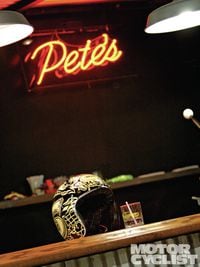Throughout Motorcyclist’s year-long centennial celebration, our MC100 timeline has focused on one decade per issue in chronological order. This month, we’re taking a break from that. Why? Do the math: We’ve got 12 issues and just 10 decades to review. Add to that the fact that this is our annual Motorcycle of the Year (and, just this once, Motorcycle of the Century) issue, and we thought it appropriate to focus on the history of the magazine itself. What started out as a bi-weekly newspaper for West Coast enthusiasts, reporting on racing results and the burgeoning “motorcycle” industry, has grown into an internationally acclaimed glossy monthly magazine that is the “journal of record” for motorcyclists. “Doing the ton” in the publishing business is a real achievement; here’s to the next 100 years!
1912
On July 1, 1912, Motorcyclist debuts as Pacific Motocycling. Cost: 5 cents per issue or 50 cents for a 1-year subscription. The mailing address is given as 317 E. 4th St., Los Angeles, California, but the personnel remain anonymous. “For the present, no names. A company has been formed and in due time the titles of the staff will be plainly hung on our handlebar,” reads an editorial. Charles Fuller Gates serves as editor/publisher for the first issue, replaced by L.J. Berger for the second.
1913
Pacific Motocycling’s name changes to Pacific Motorcyclist. Early editors continue to crank out the magazine on a bi-weekly basis, leading them to claim the “Largest Circulation West of Denver, From Canada to Mexico.”
1915
Western Journal Company buys Pacific Motorcyclist and changes the name to Pacific Motorcyclist and Western Wheelman, adding bicycle content.
1920
The magazine’s name changes again to Western Motorcyclist and Bicyclist. Following World War I, motorcycle sales decreased as manufacturers thinned out.
1925
The Motorcycle & Allied Trades Association, successor to the Federation of American Motorcyclists, re-registers as the American Motorcycle Association. The occasion is enthusiastically reported in the May 20, 1925, issue of Western Motorcyclist and Bicyclist. Annual membership costs $1.
1932
Western Motorcyclist and Bicyclist becomes the official publication of the AMA, and the title is changed to The Motorcyclist. The union helps the magazine weather the Depression, when all other motorcycle magazines go bust.
1940
The Motorcyclist drops the The to become, simply, Motorcyclist.
1943
Motorcyclist separates from the AMA. Arthur E. Welch serves as editor through World War II, and becomes publisher in 1945. Bill Smith replaces him as editor-in-chief.
1952
Bill Bagnall begins 20-year run as Motorcyclist’s editor.
1959
Inflation: Motorcyclist’s cover price is raised from 35 to 50 cents.
1962
Motorcyclist celebrates its Golden Anniversary with a special commemorative issue featuring a gold cover. That same year, rival Cycle World publishes its first issue.
1965
Editor Bill Bagnall starts his own publishing company and purchases Motorcyclist. He and wife Shirlee run the business until selling it in 1972.
1972
Petersen Publishing purchases Motorcyclist. Bob Greene becomes editor.
1976
Dave Ekins, brother of famed racer-turned-stuntman Bud Ekins, takes over as editor of Motorcyclist.
1977
Dale Boller takes the editor’s chair, and establishes a number of long-standing Motorcyclist traditions such as the “Off the Record” road-test comments.
1979
Art Friedman and Jeff Karr join the Motorcyclist staff.
1980
Motorcyclist publishes its 1000th issue. Art Friedman replaces Dale Boller as editor.
1980
Motorcyclist logo changes from the classic exhaust-pipe “y” to a stacked logo similar to that used today.
1981
Last dirtbike appears on the cover of Motorcyclist as the magazine goes to an all-street format, leaving coverage of dirtbikes to sister start-up Dirt Rider.
1984
Motorcycle of the Year (MOTY) awards debut. Mitch Boehm and Nick Ienatsch join the Motorcyclist staff.
1989
Mitch Boehm leaves Motorcyclist to work in American Honda’s R&D; department. He later does time at rival Cycle World.
1993
Petersen Publishing moves from its old Sunset Boulevard offices a few miles southwest to Wilshire Boulevard.
Art Friedman steps down as editor of Motorcyclist. Mitch Boehm returns as editor-in-chief.
1996
Petersen Publishing sells to a group of private investors for $450 million.
1999
British firm EMAP purchases Petersen Publishing for $2 billion. This venture lasts just two years, and EMAP loses millions.
2001
Primedia snatches up EMAP’s American publishing division for a scant $505 million. The company holds it for 6 years before selling at a huge profit.
2005
Brian Catterson joins the Motorcyclist staff after 12 years at Cycle World. One year later he’s promoted to editor-in-chief when Mitch Boehm departs to edit Motorcyclist Retro.
2007
Motorcyclist returns dirtbikes to the editorial mix. Reader response is overwhelmingly positive.
2007
Source Interlink Media purchases Primedia’s enthusiast media division for $1.2 billion.
2009
Source Interlink Media relocates from Los Angeles to El Segundo. The new headquarters boast an impressive photo studio and workshop, the latter including a bar named “Pete’s” in honor of Robert “Pete” Petersen.
2012
Motorcyclist celebrates its 100th anniversary as the longest continually published motorcycle magazine in the world. Italy’s Motociclismo is 2 years younger.































/cloudfront-us-east-1.images.arcpublishing.com/octane/2WF3SCE3NFBQXLDNJM7KMXA45E.jpg)
/cloudfront-us-east-1.images.arcpublishing.com/octane/G4MG6OUCJNBSHIS2MVVOTPX65E.jpg)
/cloudfront-us-east-1.images.arcpublishing.com/octane/IIGGWFOTOJGB7DB6DGBXCCMTDY.jpg)
/cloudfront-us-east-1.images.arcpublishing.com/octane/QSTCM6AVEZA5JJBUXNIQ3DSOF4.jpg)
/cloudfront-us-east-1.images.arcpublishing.com/octane/U4I7G625B5DMLF2DVIJDFZVV6M.jpg)
/cloudfront-us-east-1.images.arcpublishing.com/octane/B6XD6LS6IVCQPIU6HXDJSM3FHY.jpg)
/cloudfront-us-east-1.images.arcpublishing.com/octane/ICL63FEDDRDTTMINYICCEYGMDA.jpg)
/cloudfront-us-east-1.images.arcpublishing.com/octane/FCGZHQXRBZFLBAPC5SDIQLVF4I.jpg)
/cloudfront-us-east-1.images.arcpublishing.com/octane/WNOB6LDOIFFHJKPSVIWDYUGOPM.jpg)

/cloudfront-us-east-1.images.arcpublishing.com/octane/X33NU3E525ECRHXLNUJN2FTRKI.jpg)
/cloudfront-us-east-1.images.arcpublishing.com/octane/6KKT5NNL2JAVBOXMZYS5ZO76YA.jpg)
/cloudfront-us-east-1.images.arcpublishing.com/octane/J5RKG5O455GMPGQRF2OG6LRT7A.jpg)
/cloudfront-us-east-1.images.arcpublishing.com/octane/GX2CIZKQVRH2TATDM26KFG2DAE.jpg)
/cloudfront-us-east-1.images.arcpublishing.com/octane/ZWIDYSAKQZHD5BHREMQILXJCGM.jpg)
/cloudfront-us-east-1.images.arcpublishing.com/octane/CYUHJZCTSJCH3MRAQEIKXK7SCQ.jpg)
/cloudfront-us-east-1.images.arcpublishing.com/octane/LKOFINY56FCXJCANJ5M7ZDQUBY.jpg)
/cloudfront-us-east-1.images.arcpublishing.com/octane/4NBPDACMWJH63JQYJVK3QRBDZI.jpg)
/cloudfront-us-east-1.images.arcpublishing.com/octane/KKHQHRR3FJGX7H2IPU6RALMWG4.jpg)

/cloudfront-us-east-1.images.arcpublishing.com/octane/5IOFS5JAE5FOXMNA23ZRAVVYUU.jpg)
/cloudfront-us-east-1.images.arcpublishing.com/octane/CGXQ3O2VVJF7PGTYR3QICTLDLM.jpg)

/cloudfront-us-east-1.images.arcpublishing.com/octane/OQVCJOABCFC5NBEF2KIGRCV3XA.jpg)